Revolution in Nursing Education: Problem Based Learning Approach
VerifiedAdded on 2023/06/07
|13
|3622
|252
AI Summary
The article discusses the need for a revolution in nursing education and the benefits of problem based learning approach. It highlights the importance of critical thinking, problem solving and communication skills in nursing. The article also reviews previous studies on the effectiveness of PBL in developing critical thinking skills among nursing students.
Contribute Materials
Your contribution can guide someone’s learning journey. Share your
documents today.
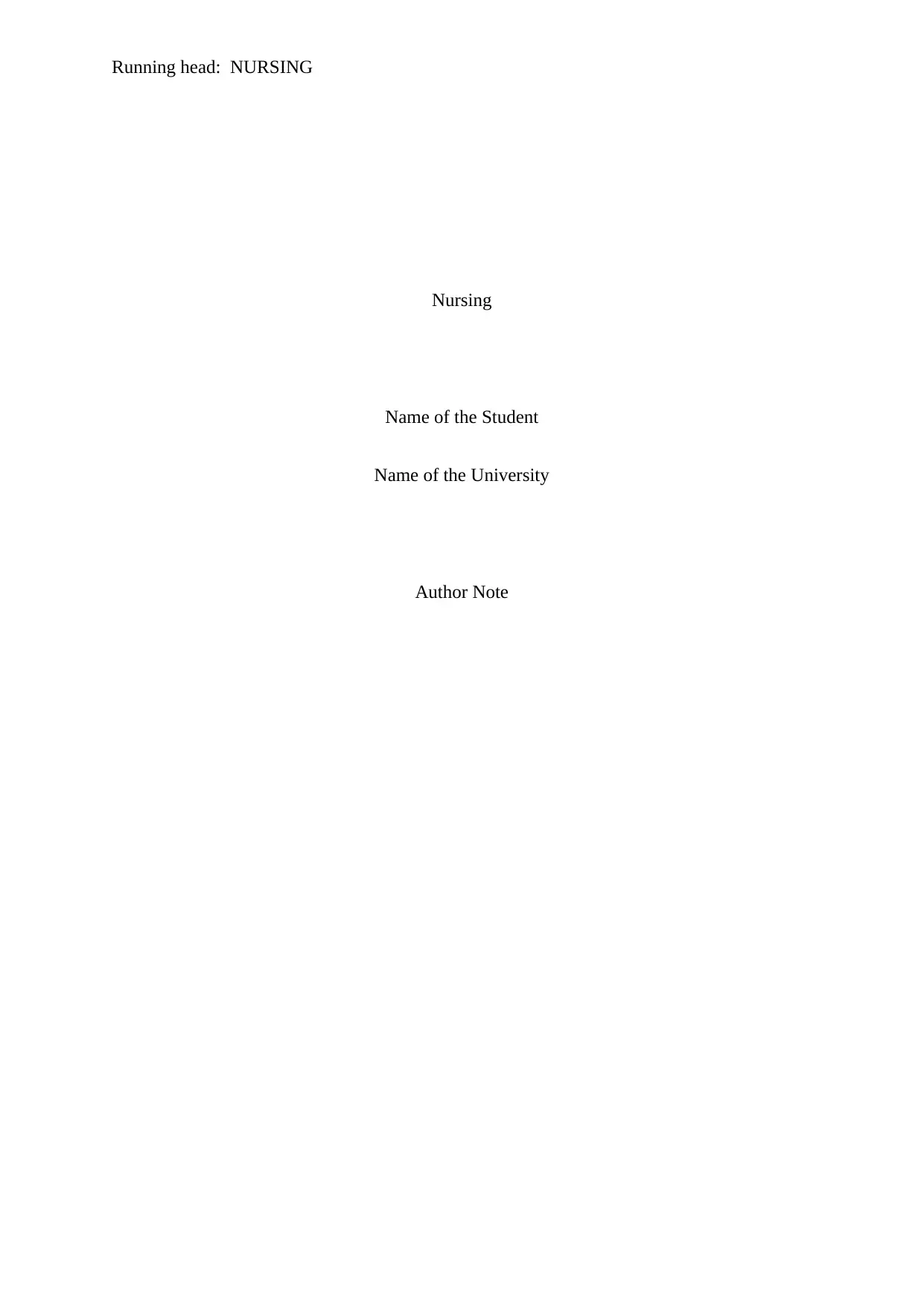
Running head: NURSING
Nursing
Name of the Student
Name of the University
Author Note
Nursing
Name of the Student
Name of the University
Author Note
Secure Best Marks with AI Grader
Need help grading? Try our AI Grader for instant feedback on your assignments.
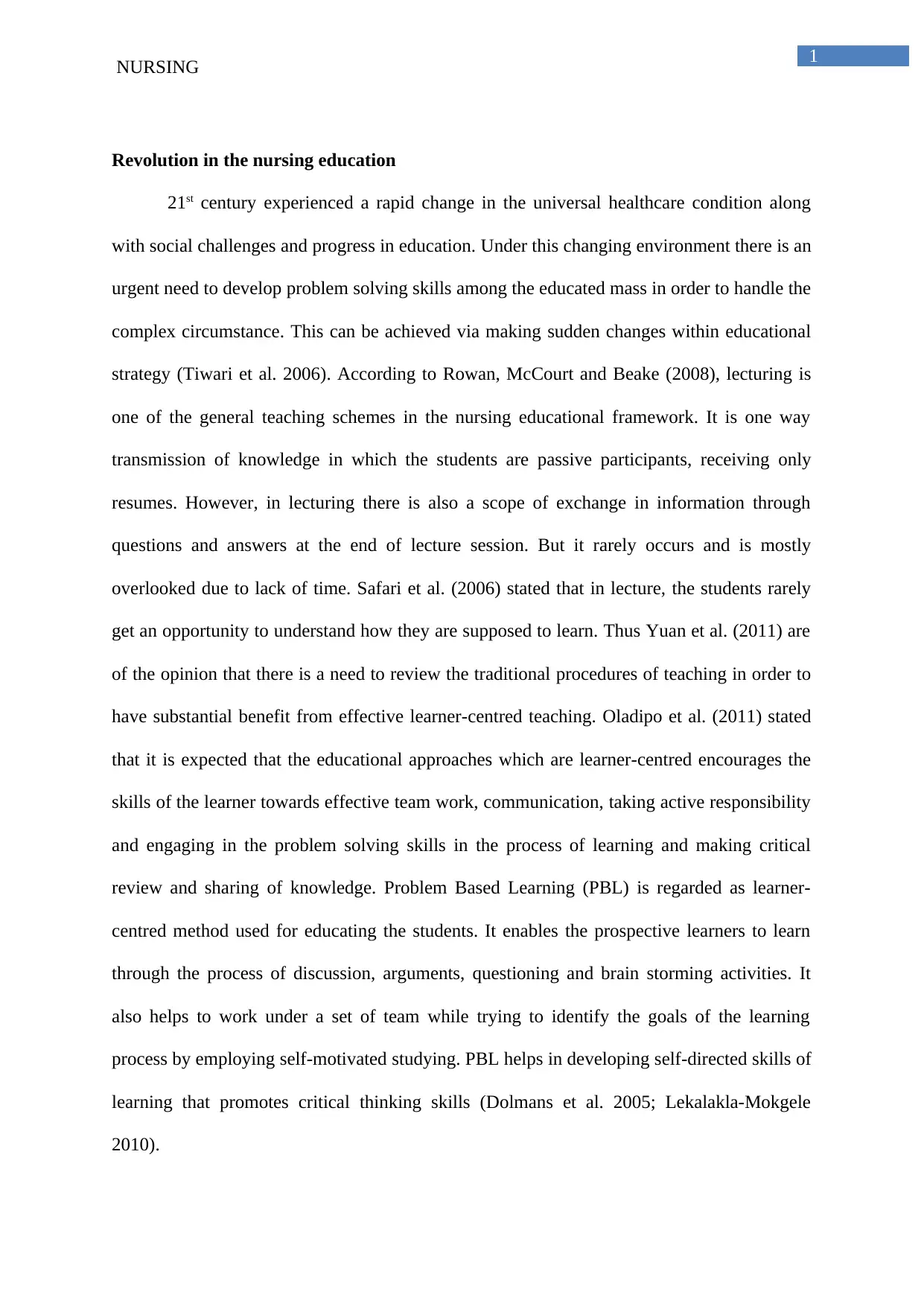
1
NURSING
Revolution in the nursing education
21st century experienced a rapid change in the universal healthcare condition along
with social challenges and progress in education. Under this changing environment there is an
urgent need to develop problem solving skills among the educated mass in order to handle the
complex circumstance. This can be achieved via making sudden changes within educational
strategy (Tiwari et al. 2006). According to Rowan, McCourt and Beake (2008), lecturing is
one of the general teaching schemes in the nursing educational framework. It is one way
transmission of knowledge in which the students are passive participants, receiving only
resumes. However, in lecturing there is also a scope of exchange in information through
questions and answers at the end of lecture session. But it rarely occurs and is mostly
overlooked due to lack of time. Safari et al. (2006) stated that in lecture, the students rarely
get an opportunity to understand how they are supposed to learn. Thus Yuan et al. (2011) are
of the opinion that there is a need to review the traditional procedures of teaching in order to
have substantial benefit from effective learner-centred teaching. Oladipo et al. (2011) stated
that it is expected that the educational approaches which are learner-centred encourages the
skills of the learner towards effective team work, communication, taking active responsibility
and engaging in the problem solving skills in the process of learning and making critical
review and sharing of knowledge. Problem Based Learning (PBL) is regarded as learner-
centred method used for educating the students. It enables the prospective learners to learn
through the process of discussion, arguments, questioning and brain storming activities. It
also helps to work under a set of team while trying to identify the goals of the learning
process by employing self-motivated studying. PBL helps in developing self-directed skills of
learning that promotes critical thinking skills (Dolmans et al. 2005; Lekalakla-Mokgele
2010).
NURSING
Revolution in the nursing education
21st century experienced a rapid change in the universal healthcare condition along
with social challenges and progress in education. Under this changing environment there is an
urgent need to develop problem solving skills among the educated mass in order to handle the
complex circumstance. This can be achieved via making sudden changes within educational
strategy (Tiwari et al. 2006). According to Rowan, McCourt and Beake (2008), lecturing is
one of the general teaching schemes in the nursing educational framework. It is one way
transmission of knowledge in which the students are passive participants, receiving only
resumes. However, in lecturing there is also a scope of exchange in information through
questions and answers at the end of lecture session. But it rarely occurs and is mostly
overlooked due to lack of time. Safari et al. (2006) stated that in lecture, the students rarely
get an opportunity to understand how they are supposed to learn. Thus Yuan et al. (2011) are
of the opinion that there is a need to review the traditional procedures of teaching in order to
have substantial benefit from effective learner-centred teaching. Oladipo et al. (2011) stated
that it is expected that the educational approaches which are learner-centred encourages the
skills of the learner towards effective team work, communication, taking active responsibility
and engaging in the problem solving skills in the process of learning and making critical
review and sharing of knowledge. Problem Based Learning (PBL) is regarded as learner-
centred method used for educating the students. It enables the prospective learners to learn
through the process of discussion, arguments, questioning and brain storming activities. It
also helps to work under a set of team while trying to identify the goals of the learning
process by employing self-motivated studying. PBL helps in developing self-directed skills of
learning that promotes critical thinking skills (Dolmans et al. 2005; Lekalakla-Mokgele
2010).
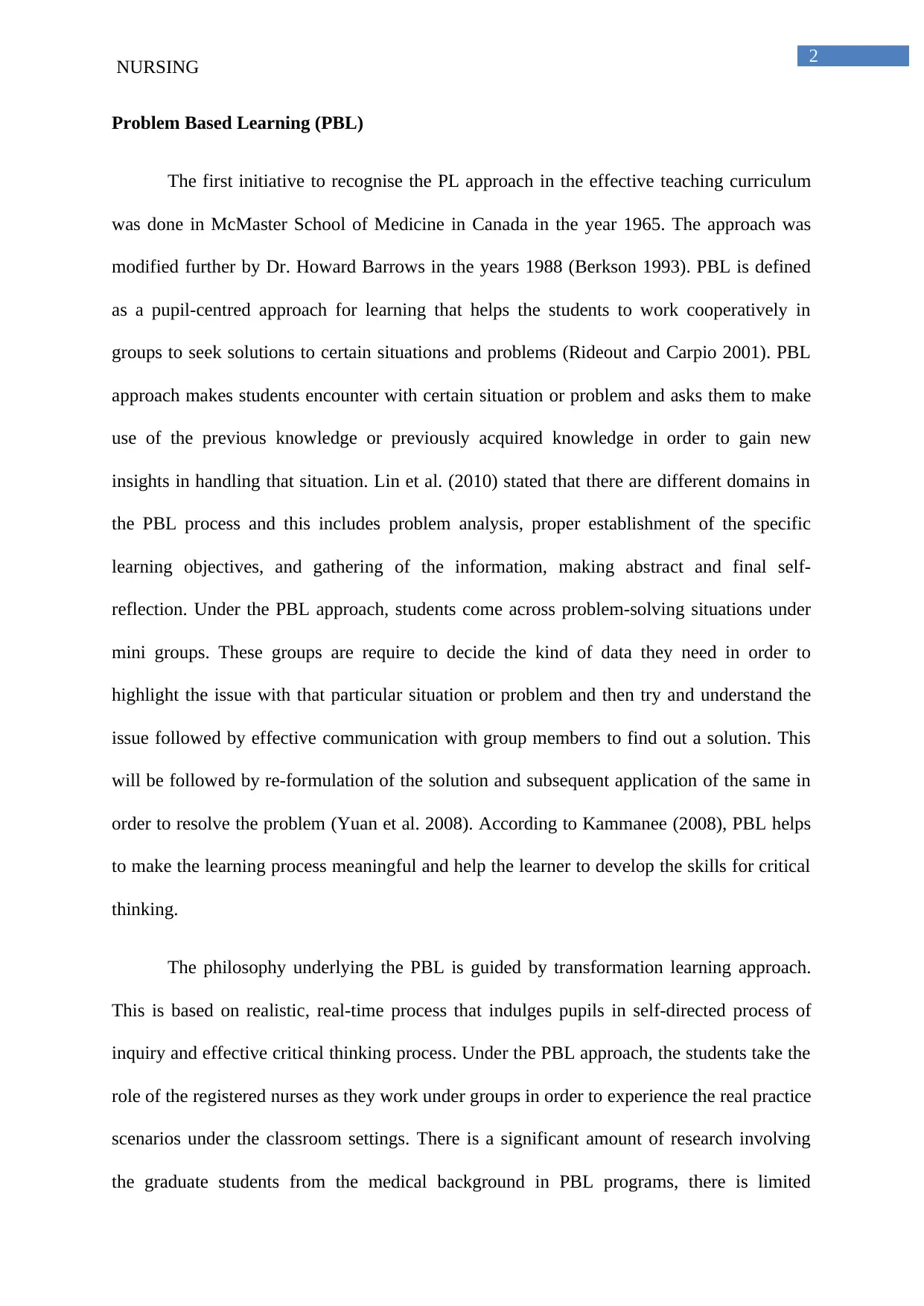
2
NURSING
Problem Based Learning (PBL)
The first initiative to recognise the PL approach in the effective teaching curriculum
was done in McMaster School of Medicine in Canada in the year 1965. The approach was
modified further by Dr. Howard Barrows in the years 1988 (Berkson 1993). PBL is defined
as a pupil-centred approach for learning that helps the students to work cooperatively in
groups to seek solutions to certain situations and problems (Rideout and Carpio 2001). PBL
approach makes students encounter with certain situation or problem and asks them to make
use of the previous knowledge or previously acquired knowledge in order to gain new
insights in handling that situation. Lin et al. (2010) stated that there are different domains in
the PBL process and this includes problem analysis, proper establishment of the specific
learning objectives, and gathering of the information, making abstract and final self-
reflection. Under the PBL approach, students come across problem-solving situations under
mini groups. These groups are require to decide the kind of data they need in order to
highlight the issue with that particular situation or problem and then try and understand the
issue followed by effective communication with group members to find out a solution. This
will be followed by re-formulation of the solution and subsequent application of the same in
order to resolve the problem (Yuan et al. 2008). According to Kammanee (2008), PBL helps
to make the learning process meaningful and help the learner to develop the skills for critical
thinking.
The philosophy underlying the PBL is guided by transformation learning approach.
This is based on realistic, real-time process that indulges pupils in self-directed process of
inquiry and effective critical thinking process. Under the PBL approach, the students take the
role of the registered nurses as they work under groups in order to experience the real practice
scenarios under the classroom settings. There is a significant amount of research involving
the graduate students from the medical background in PBL programs, there is limited
NURSING
Problem Based Learning (PBL)
The first initiative to recognise the PL approach in the effective teaching curriculum
was done in McMaster School of Medicine in Canada in the year 1965. The approach was
modified further by Dr. Howard Barrows in the years 1988 (Berkson 1993). PBL is defined
as a pupil-centred approach for learning that helps the students to work cooperatively in
groups to seek solutions to certain situations and problems (Rideout and Carpio 2001). PBL
approach makes students encounter with certain situation or problem and asks them to make
use of the previous knowledge or previously acquired knowledge in order to gain new
insights in handling that situation. Lin et al. (2010) stated that there are different domains in
the PBL process and this includes problem analysis, proper establishment of the specific
learning objectives, and gathering of the information, making abstract and final self-
reflection. Under the PBL approach, students come across problem-solving situations under
mini groups. These groups are require to decide the kind of data they need in order to
highlight the issue with that particular situation or problem and then try and understand the
issue followed by effective communication with group members to find out a solution. This
will be followed by re-formulation of the solution and subsequent application of the same in
order to resolve the problem (Yuan et al. 2008). According to Kammanee (2008), PBL helps
to make the learning process meaningful and help the learner to develop the skills for critical
thinking.
The philosophy underlying the PBL is guided by transformation learning approach.
This is based on realistic, real-time process that indulges pupils in self-directed process of
inquiry and effective critical thinking process. Under the PBL approach, the students take the
role of the registered nurses as they work under groups in order to experience the real practice
scenarios under the classroom settings. There is a significant amount of research involving
the graduate students from the medical background in PBL programs, there is limited
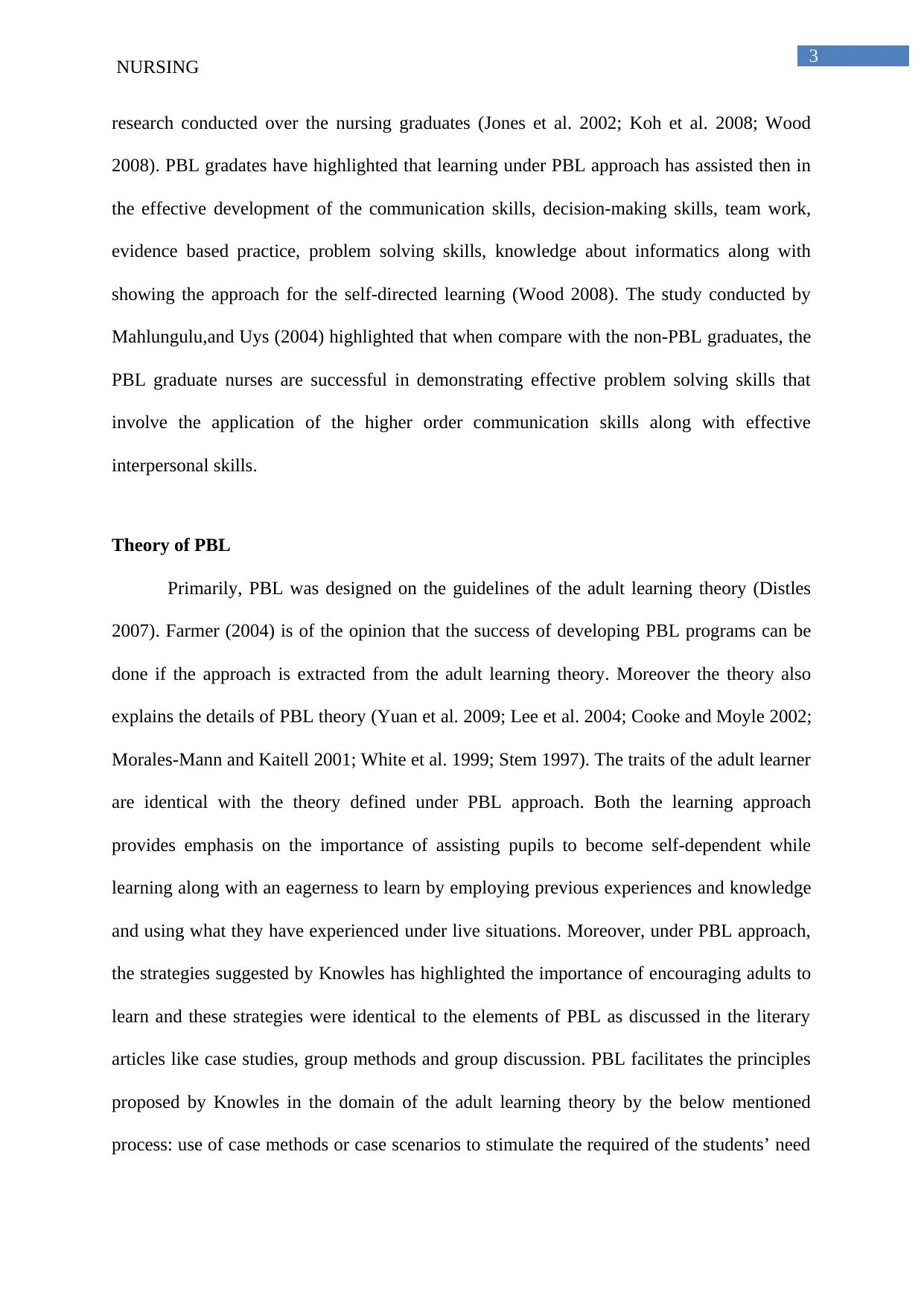
3
NURSING
research conducted over the nursing graduates (Jones et al. 2002; Koh et al. 2008; Wood
2008). PBL gradates have highlighted that learning under PBL approach has assisted then in
the effective development of the communication skills, decision-making skills, team work,
evidence based practice, problem solving skills, knowledge about informatics along with
showing the approach for the self-directed learning (Wood 2008). The study conducted by
Mahlungulu,and Uys (2004) highlighted that when compare with the non-PBL graduates, the
PBL graduate nurses are successful in demonstrating effective problem solving skills that
involve the application of the higher order communication skills along with effective
interpersonal skills.
Theory of PBL
Primarily, PBL was designed on the guidelines of the adult learning theory (Distles
2007). Farmer (2004) is of the opinion that the success of developing PBL programs can be
done if the approach is extracted from the adult learning theory. Moreover the theory also
explains the details of PBL theory (Yuan et al. 2009; Lee et al. 2004; Cooke and Moyle 2002;
Morales-Mann and Kaitell 2001; White et al. 1999; Stem 1997). The traits of the adult learner
are identical with the theory defined under PBL approach. Both the learning approach
provides emphasis on the importance of assisting pupils to become self-dependent while
learning along with an eagerness to learn by employing previous experiences and knowledge
and using what they have experienced under live situations. Moreover, under PBL approach,
the strategies suggested by Knowles has highlighted the importance of encouraging adults to
learn and these strategies were identical to the elements of PBL as discussed in the literary
articles like case studies, group methods and group discussion. PBL facilitates the principles
proposed by Knowles in the domain of the adult learning theory by the below mentioned
process: use of case methods or case scenarios to stimulate the required of the students’ need
NURSING
research conducted over the nursing graduates (Jones et al. 2002; Koh et al. 2008; Wood
2008). PBL gradates have highlighted that learning under PBL approach has assisted then in
the effective development of the communication skills, decision-making skills, team work,
evidence based practice, problem solving skills, knowledge about informatics along with
showing the approach for the self-directed learning (Wood 2008). The study conducted by
Mahlungulu,and Uys (2004) highlighted that when compare with the non-PBL graduates, the
PBL graduate nurses are successful in demonstrating effective problem solving skills that
involve the application of the higher order communication skills along with effective
interpersonal skills.
Theory of PBL
Primarily, PBL was designed on the guidelines of the adult learning theory (Distles
2007). Farmer (2004) is of the opinion that the success of developing PBL programs can be
done if the approach is extracted from the adult learning theory. Moreover the theory also
explains the details of PBL theory (Yuan et al. 2009; Lee et al. 2004; Cooke and Moyle 2002;
Morales-Mann and Kaitell 2001; White et al. 1999; Stem 1997). The traits of the adult learner
are identical with the theory defined under PBL approach. Both the learning approach
provides emphasis on the importance of assisting pupils to become self-dependent while
learning along with an eagerness to learn by employing previous experiences and knowledge
and using what they have experienced under live situations. Moreover, under PBL approach,
the strategies suggested by Knowles has highlighted the importance of encouraging adults to
learn and these strategies were identical to the elements of PBL as discussed in the literary
articles like case studies, group methods and group discussion. PBL facilitates the principles
proposed by Knowles in the domain of the adult learning theory by the below mentioned
process: use of case methods or case scenarios to stimulate the required of the students’ need
Secure Best Marks with AI Grader
Need help grading? Try our AI Grader for instant feedback on your assignments.
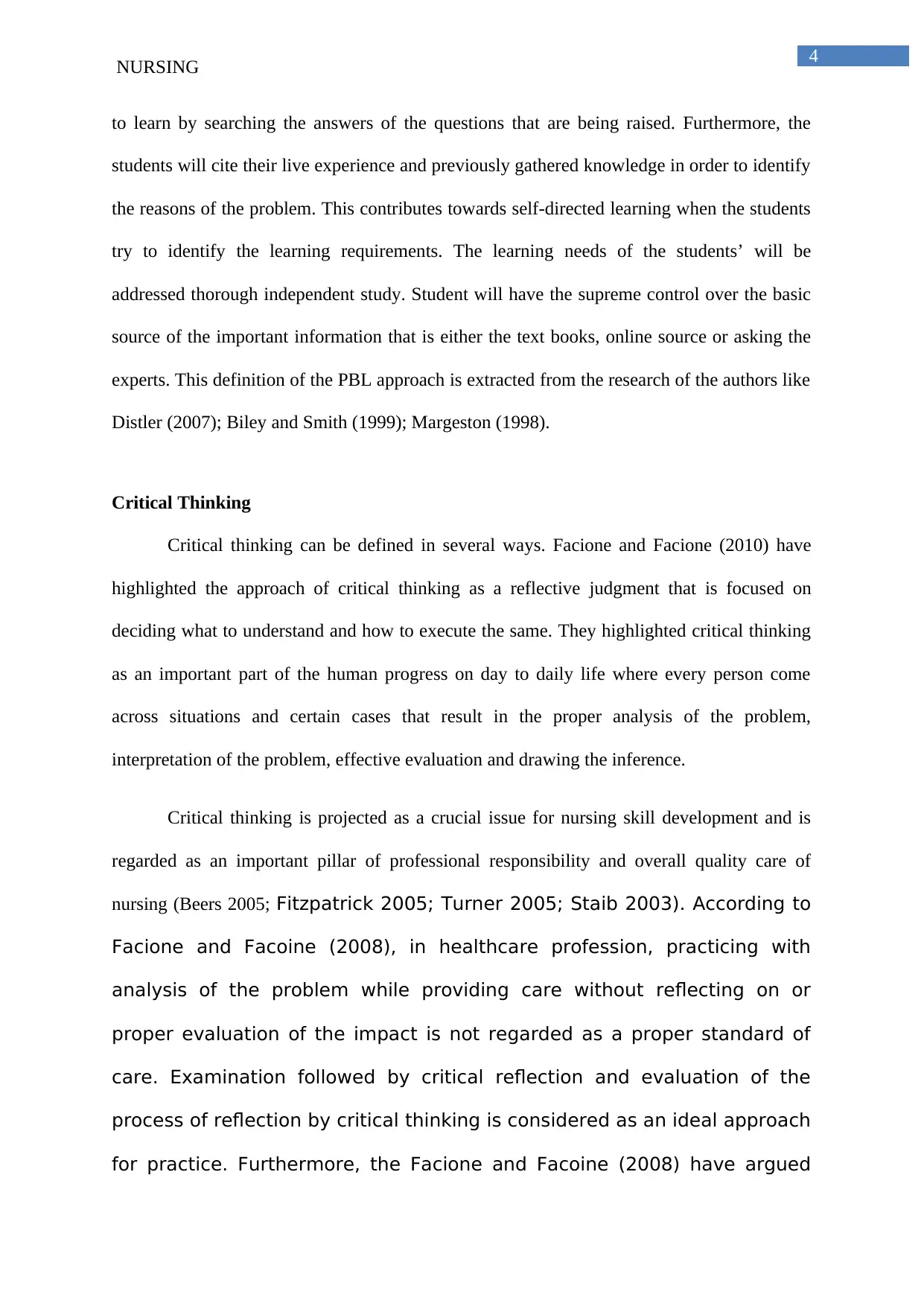
4
NURSING
to learn by searching the answers of the questions that are being raised. Furthermore, the
students will cite their live experience and previously gathered knowledge in order to identify
the reasons of the problem. This contributes towards self-directed learning when the students
try to identify the learning requirements. The learning needs of the students’ will be
addressed thorough independent study. Student will have the supreme control over the basic
source of the important information that is either the text books, online source or asking the
experts. This definition of the PBL approach is extracted from the research of the authors like
Distler (2007); Biley and Smith (1999); Margeston (1998).
Critical Thinking
Critical thinking can be defined in several ways. Facione and Facione (2010) have
highlighted the approach of critical thinking as a reflective judgment that is focused on
deciding what to understand and how to execute the same. They highlighted critical thinking
as an important part of the human progress on day to daily life where every person come
across situations and certain cases that result in the proper analysis of the problem,
interpretation of the problem, effective evaluation and drawing the inference.
Critical thinking is projected as a crucial issue for nursing skill development and is
regarded as an important pillar of professional responsibility and overall quality care of
nursing (Beers 2005; Fitzpatrick 2005; Turner 2005; Staib 2003). According to
Facione and Facoine (2008), in healthcare profession, practicing with
analysis of the problem while providing care without reflecting on or
proper evaluation of the impact is not regarded as a proper standard of
care. Examination followed by critical reflection and evaluation of the
process of reflection by critical thinking is considered as an ideal approach
for practice. Furthermore, the Facione and Facoine (2008) have argued
NURSING
to learn by searching the answers of the questions that are being raised. Furthermore, the
students will cite their live experience and previously gathered knowledge in order to identify
the reasons of the problem. This contributes towards self-directed learning when the students
try to identify the learning requirements. The learning needs of the students’ will be
addressed thorough independent study. Student will have the supreme control over the basic
source of the important information that is either the text books, online source or asking the
experts. This definition of the PBL approach is extracted from the research of the authors like
Distler (2007); Biley and Smith (1999); Margeston (1998).
Critical Thinking
Critical thinking can be defined in several ways. Facione and Facione (2010) have
highlighted the approach of critical thinking as a reflective judgment that is focused on
deciding what to understand and how to execute the same. They highlighted critical thinking
as an important part of the human progress on day to daily life where every person come
across situations and certain cases that result in the proper analysis of the problem,
interpretation of the problem, effective evaluation and drawing the inference.
Critical thinking is projected as a crucial issue for nursing skill development and is
regarded as an important pillar of professional responsibility and overall quality care of
nursing (Beers 2005; Fitzpatrick 2005; Turner 2005; Staib 2003). According to
Facione and Facoine (2008), in healthcare profession, practicing with
analysis of the problem while providing care without reflecting on or
proper evaluation of the impact is not regarded as a proper standard of
care. Examination followed by critical reflection and evaluation of the
process of reflection by critical thinking is considered as an ideal approach
for practice. Furthermore, the Facione and Facoine (2008) have argued
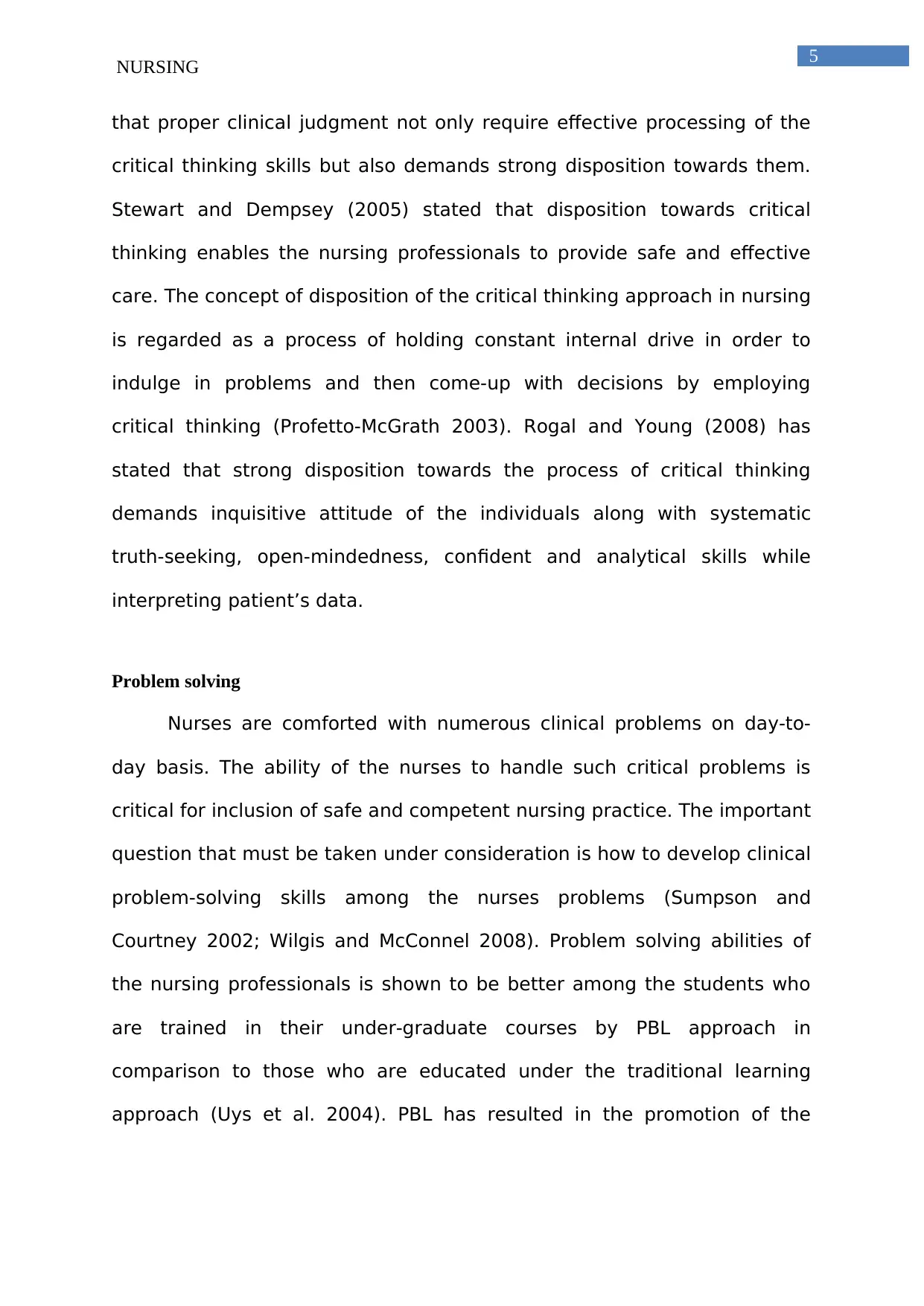
5
NURSING
that proper clinical judgment not only require effective processing of the
critical thinking skills but also demands strong disposition towards them.
Stewart and Dempsey (2005) stated that disposition towards critical
thinking enables the nursing professionals to provide safe and effective
care. The concept of disposition of the critical thinking approach in nursing
is regarded as a process of holding constant internal drive in order to
indulge in problems and then come-up with decisions by employing
critical thinking (Profetto-McGrath 2003). Rogal and Young (2008) has
stated that strong disposition towards the process of critical thinking
demands inquisitive attitude of the individuals along with systematic
truth-seeking, open-mindedness, confident and analytical skills while
interpreting patient’s data.
Problem solving
Nurses are comforted with numerous clinical problems on day-to-
day basis. The ability of the nurses to handle such critical problems is
critical for inclusion of safe and competent nursing practice. The important
question that must be taken under consideration is how to develop clinical
problem-solving skills among the nurses problems (Sumpson and
Courtney 2002; Wilgis and McConnel 2008). Problem solving abilities of
the nursing professionals is shown to be better among the students who
are trained in their under-graduate courses by PBL approach in
comparison to those who are educated under the traditional learning
approach (Uys et al. 2004). PBL has resulted in the promotion of the
NURSING
that proper clinical judgment not only require effective processing of the
critical thinking skills but also demands strong disposition towards them.
Stewart and Dempsey (2005) stated that disposition towards critical
thinking enables the nursing professionals to provide safe and effective
care. The concept of disposition of the critical thinking approach in nursing
is regarded as a process of holding constant internal drive in order to
indulge in problems and then come-up with decisions by employing
critical thinking (Profetto-McGrath 2003). Rogal and Young (2008) has
stated that strong disposition towards the process of critical thinking
demands inquisitive attitude of the individuals along with systematic
truth-seeking, open-mindedness, confident and analytical skills while
interpreting patient’s data.
Problem solving
Nurses are comforted with numerous clinical problems on day-to-
day basis. The ability of the nurses to handle such critical problems is
critical for inclusion of safe and competent nursing practice. The important
question that must be taken under consideration is how to develop clinical
problem-solving skills among the nurses problems (Sumpson and
Courtney 2002; Wilgis and McConnel 2008). Problem solving abilities of
the nursing professionals is shown to be better among the students who
are trained in their under-graduate courses by PBL approach in
comparison to those who are educated under the traditional learning
approach (Uys et al. 2004). PBL has resulted in the promotion of the
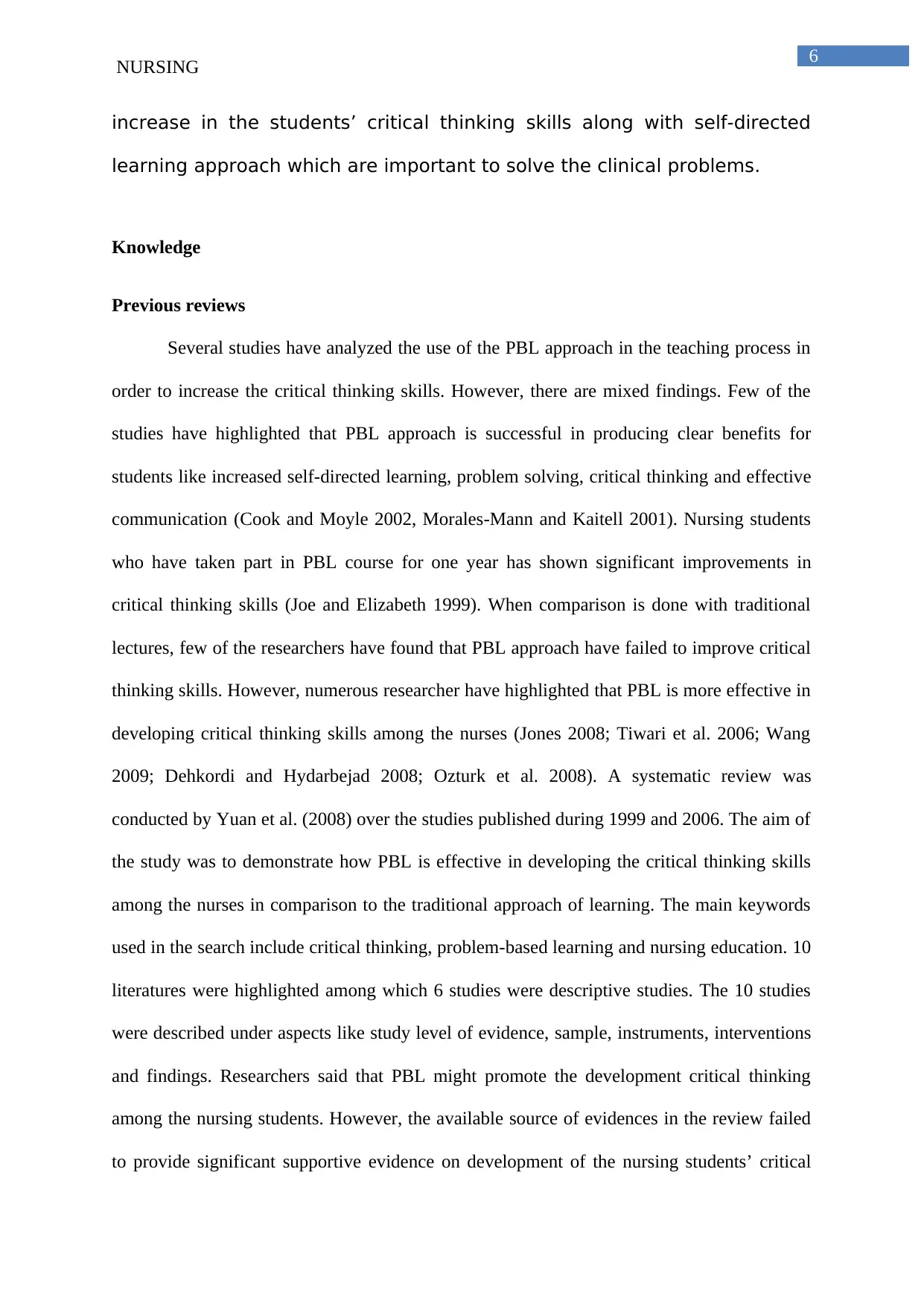
6
NURSING
increase in the students’ critical thinking skills along with self-directed
learning approach which are important to solve the clinical problems.
Knowledge
Previous reviews
Several studies have analyzed the use of the PBL approach in the teaching process in
order to increase the critical thinking skills. However, there are mixed findings. Few of the
studies have highlighted that PBL approach is successful in producing clear benefits for
students like increased self-directed learning, problem solving, critical thinking and effective
communication (Cook and Moyle 2002, Morales-Mann and Kaitell 2001). Nursing students
who have taken part in PBL course for one year has shown significant improvements in
critical thinking skills (Joe and Elizabeth 1999). When comparison is done with traditional
lectures, few of the researchers have found that PBL approach have failed to improve critical
thinking skills. However, numerous researcher have highlighted that PBL is more effective in
developing critical thinking skills among the nurses (Jones 2008; Tiwari et al. 2006; Wang
2009; Dehkordi and Hydarbejad 2008; Ozturk et al. 2008). A systematic review was
conducted by Yuan et al. (2008) over the studies published during 1999 and 2006. The aim of
the study was to demonstrate how PBL is effective in developing the critical thinking skills
among the nurses in comparison to the traditional approach of learning. The main keywords
used in the search include critical thinking, problem-based learning and nursing education. 10
literatures were highlighted among which 6 studies were descriptive studies. The 10 studies
were described under aspects like study level of evidence, sample, instruments, interventions
and findings. Researchers said that PBL might promote the development critical thinking
among the nursing students. However, the available source of evidences in the review failed
to provide significant supportive evidence on development of the nursing students’ critical
NURSING
increase in the students’ critical thinking skills along with self-directed
learning approach which are important to solve the clinical problems.
Knowledge
Previous reviews
Several studies have analyzed the use of the PBL approach in the teaching process in
order to increase the critical thinking skills. However, there are mixed findings. Few of the
studies have highlighted that PBL approach is successful in producing clear benefits for
students like increased self-directed learning, problem solving, critical thinking and effective
communication (Cook and Moyle 2002, Morales-Mann and Kaitell 2001). Nursing students
who have taken part in PBL course for one year has shown significant improvements in
critical thinking skills (Joe and Elizabeth 1999). When comparison is done with traditional
lectures, few of the researchers have found that PBL approach have failed to improve critical
thinking skills. However, numerous researcher have highlighted that PBL is more effective in
developing critical thinking skills among the nurses (Jones 2008; Tiwari et al. 2006; Wang
2009; Dehkordi and Hydarbejad 2008; Ozturk et al. 2008). A systematic review was
conducted by Yuan et al. (2008) over the studies published during 1999 and 2006. The aim of
the study was to demonstrate how PBL is effective in developing the critical thinking skills
among the nurses in comparison to the traditional approach of learning. The main keywords
used in the search include critical thinking, problem-based learning and nursing education. 10
literatures were highlighted among which 6 studies were descriptive studies. The 10 studies
were described under aspects like study level of evidence, sample, instruments, interventions
and findings. Researchers said that PBL might promote the development critical thinking
among the nursing students. However, the available source of evidences in the review failed
to provide significant supportive evidence on development of the nursing students’ critical
Paraphrase This Document
Need a fresh take? Get an instant paraphrase of this document with our AI Paraphraser
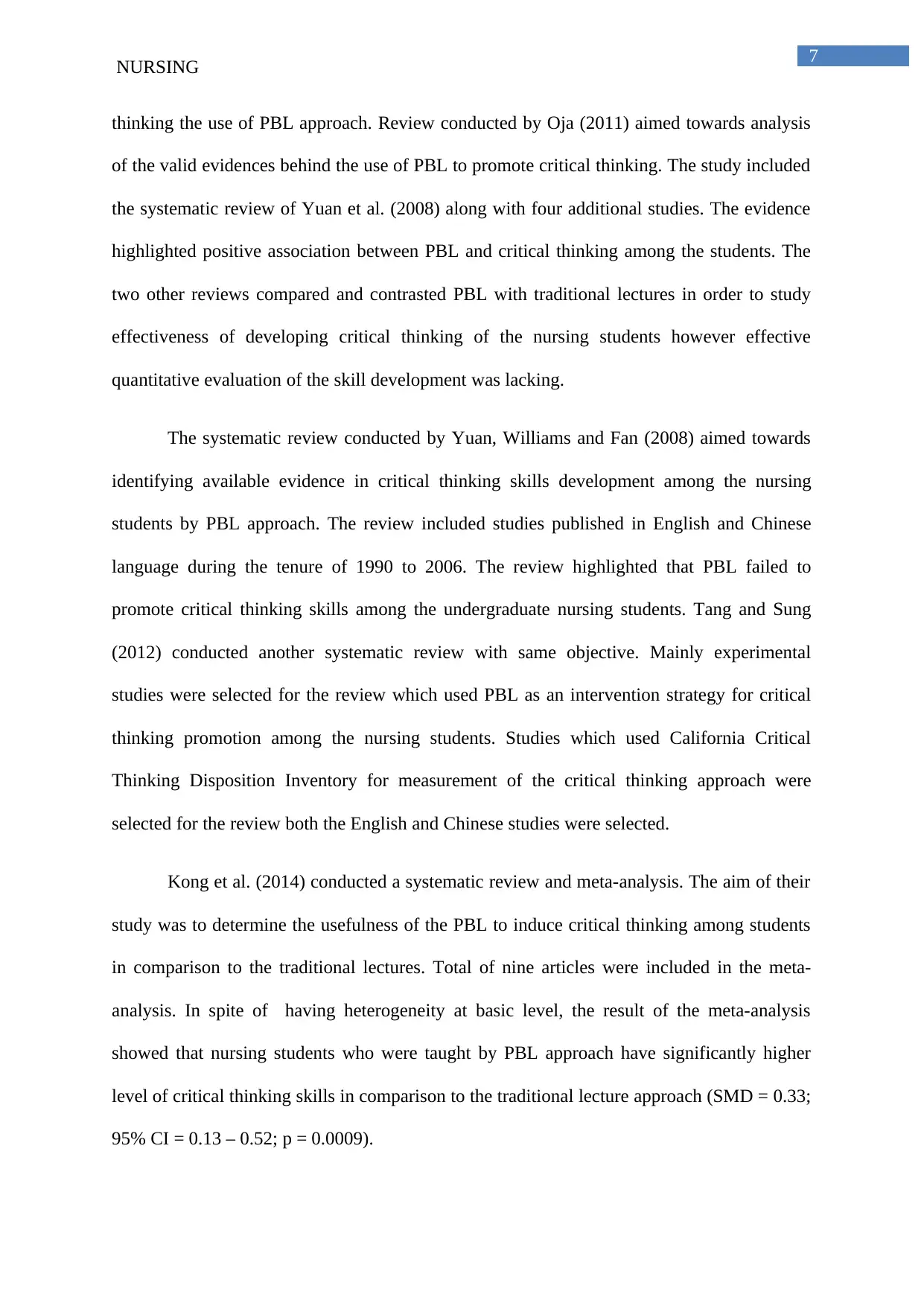
7
NURSING
thinking the use of PBL approach. Review conducted by Oja (2011) aimed towards analysis
of the valid evidences behind the use of PBL to promote critical thinking. The study included
the systematic review of Yuan et al. (2008) along with four additional studies. The evidence
highlighted positive association between PBL and critical thinking among the students. The
two other reviews compared and contrasted PBL with traditional lectures in order to study
effectiveness of developing critical thinking of the nursing students however effective
quantitative evaluation of the skill development was lacking.
The systematic review conducted by Yuan, Williams and Fan (2008) aimed towards
identifying available evidence in critical thinking skills development among the nursing
students by PBL approach. The review included studies published in English and Chinese
language during the tenure of 1990 to 2006. The review highlighted that PBL failed to
promote critical thinking skills among the undergraduate nursing students. Tang and Sung
(2012) conducted another systematic review with same objective. Mainly experimental
studies were selected for the review which used PBL as an intervention strategy for critical
thinking promotion among the nursing students. Studies which used California Critical
Thinking Disposition Inventory for measurement of the critical thinking approach were
selected for the review both the English and Chinese studies were selected.
Kong et al. (2014) conducted a systematic review and meta-analysis. The aim of their
study was to determine the usefulness of the PBL to induce critical thinking among students
in comparison to the traditional lectures. Total of nine articles were included in the meta-
analysis. In spite of having heterogeneity at basic level, the result of the meta-analysis
showed that nursing students who were taught by PBL approach have significantly higher
level of critical thinking skills in comparison to the traditional lecture approach (SMD = 0.33;
95% CI = 0.13 – 0.52; p = 0.0009).
NURSING
thinking the use of PBL approach. Review conducted by Oja (2011) aimed towards analysis
of the valid evidences behind the use of PBL to promote critical thinking. The study included
the systematic review of Yuan et al. (2008) along with four additional studies. The evidence
highlighted positive association between PBL and critical thinking among the students. The
two other reviews compared and contrasted PBL with traditional lectures in order to study
effectiveness of developing critical thinking of the nursing students however effective
quantitative evaluation of the skill development was lacking.
The systematic review conducted by Yuan, Williams and Fan (2008) aimed towards
identifying available evidence in critical thinking skills development among the nursing
students by PBL approach. The review included studies published in English and Chinese
language during the tenure of 1990 to 2006. The review highlighted that PBL failed to
promote critical thinking skills among the undergraduate nursing students. Tang and Sung
(2012) conducted another systematic review with same objective. Mainly experimental
studies were selected for the review which used PBL as an intervention strategy for critical
thinking promotion among the nursing students. Studies which used California Critical
Thinking Disposition Inventory for measurement of the critical thinking approach were
selected for the review both the English and Chinese studies were selected.
Kong et al. (2014) conducted a systematic review and meta-analysis. The aim of their
study was to determine the usefulness of the PBL to induce critical thinking among students
in comparison to the traditional lectures. Total of nine articles were included in the meta-
analysis. In spite of having heterogeneity at basic level, the result of the meta-analysis
showed that nursing students who were taught by PBL approach have significantly higher
level of critical thinking skills in comparison to the traditional lecture approach (SMD = 0.33;
95% CI = 0.13 – 0.52; p = 0.0009).
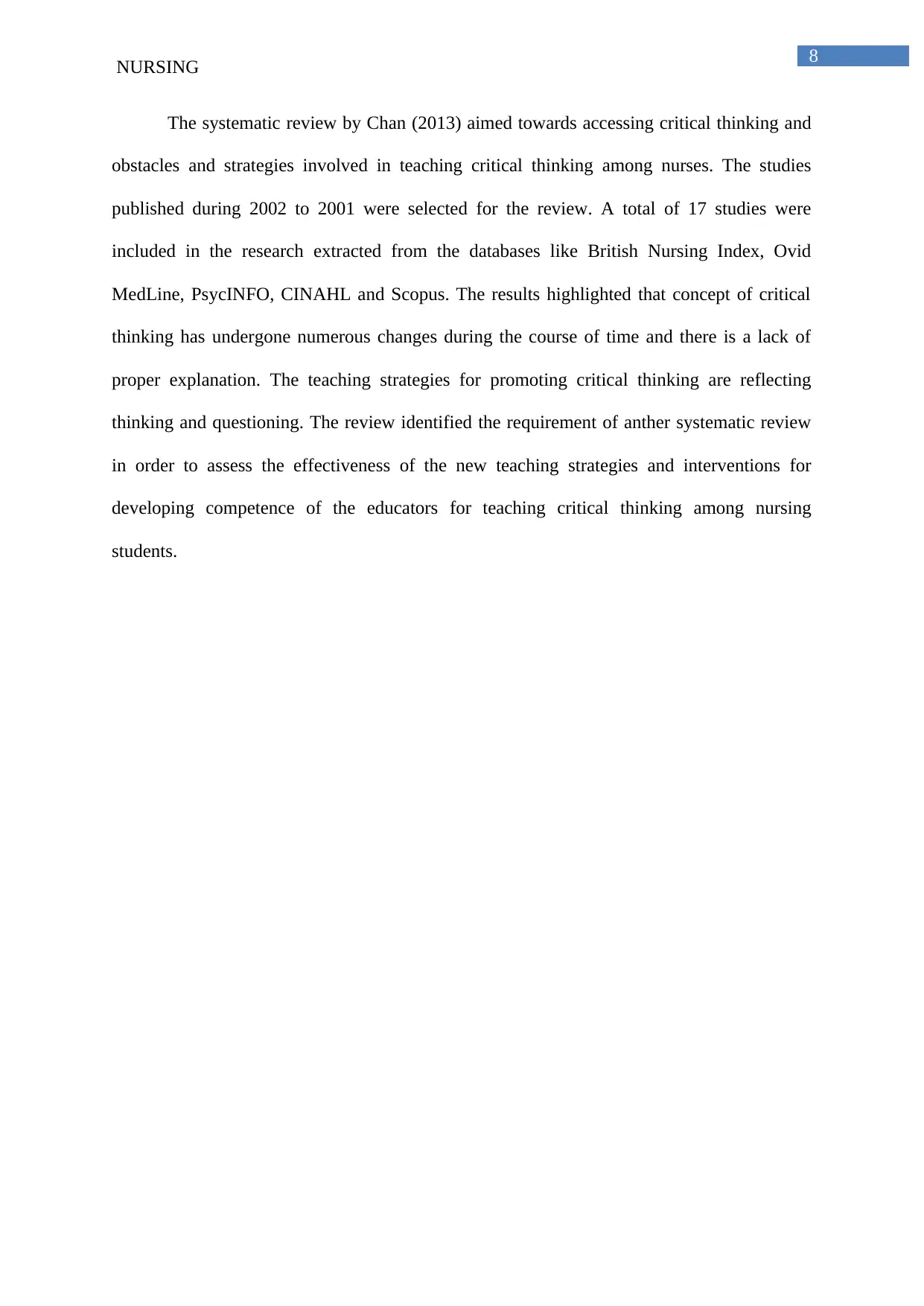
8
NURSING
The systematic review by Chan (2013) aimed towards accessing critical thinking and
obstacles and strategies involved in teaching critical thinking among nurses. The studies
published during 2002 to 2001 were selected for the review. A total of 17 studies were
included in the research extracted from the databases like British Nursing Index, Ovid
MedLine, PsycINFO, CINAHL and Scopus. The results highlighted that concept of critical
thinking has undergone numerous changes during the course of time and there is a lack of
proper explanation. The teaching strategies for promoting critical thinking are reflecting
thinking and questioning. The review identified the requirement of anther systematic review
in order to assess the effectiveness of the new teaching strategies and interventions for
developing competence of the educators for teaching critical thinking among nursing
students.
NURSING
The systematic review by Chan (2013) aimed towards accessing critical thinking and
obstacles and strategies involved in teaching critical thinking among nurses. The studies
published during 2002 to 2001 were selected for the review. A total of 17 studies were
included in the research extracted from the databases like British Nursing Index, Ovid
MedLine, PsycINFO, CINAHL and Scopus. The results highlighted that concept of critical
thinking has undergone numerous changes during the course of time and there is a lack of
proper explanation. The teaching strategies for promoting critical thinking are reflecting
thinking and questioning. The review identified the requirement of anther systematic review
in order to assess the effectiveness of the new teaching strategies and interventions for
developing competence of the educators for teaching critical thinking among nursing
students.
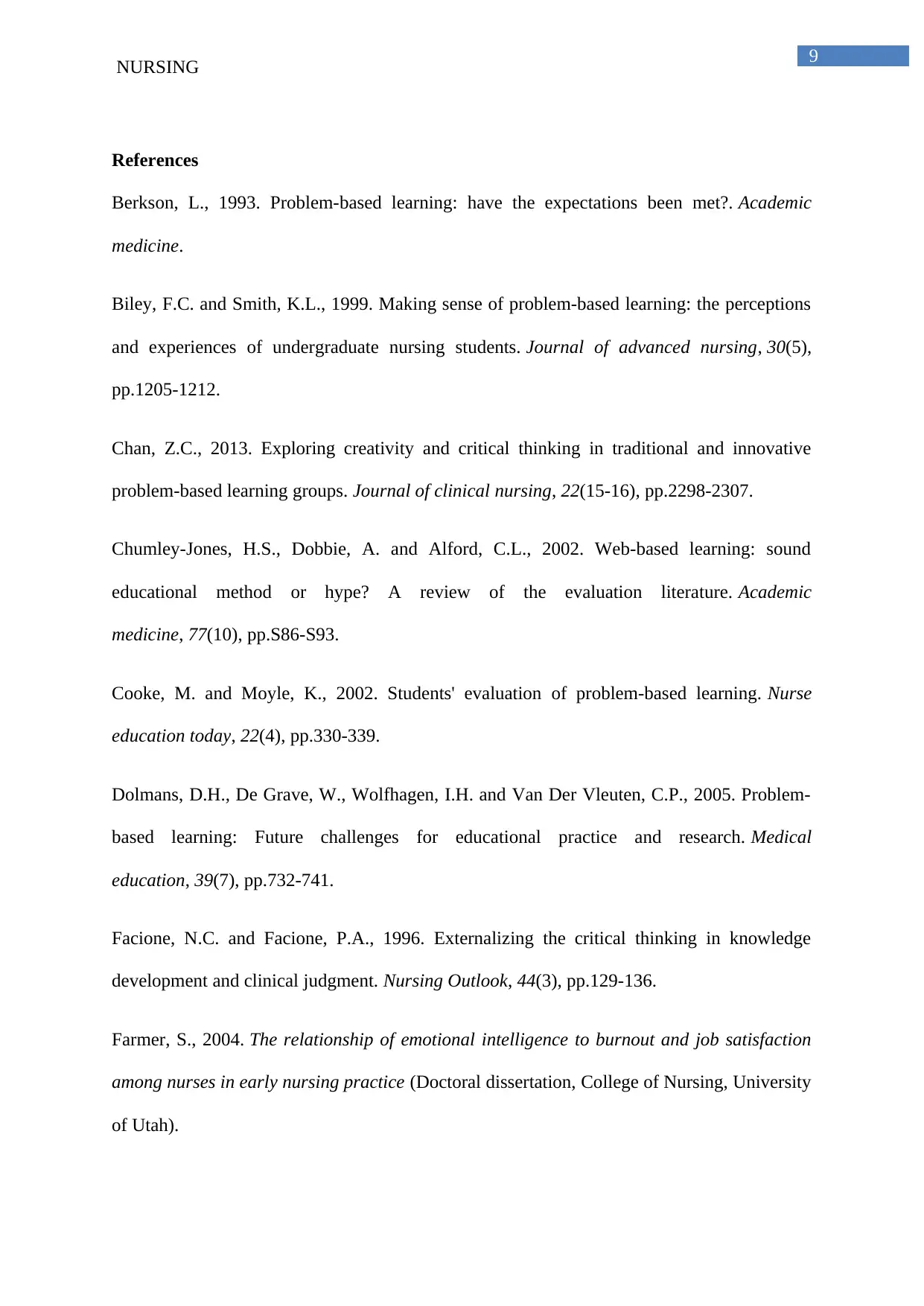
9
NURSING
References
Berkson, L., 1993. Problem-based learning: have the expectations been met?. Academic
medicine.
Biley, F.C. and Smith, K.L., 1999. Making sense of problem‐based learning: the perceptions
and experiences of undergraduate nursing students. Journal of advanced nursing, 30(5),
pp.1205-1212.
Chan, Z.C., 2013. Exploring creativity and critical thinking in traditional and innovative
problem‐based learning groups. Journal of clinical nursing, 22(15-16), pp.2298-2307.
Chumley-Jones, H.S., Dobbie, A. and Alford, C.L., 2002. Web-based learning: sound
educational method or hype? A review of the evaluation literature. Academic
medicine, 77(10), pp.S86-S93.
Cooke, M. and Moyle, K., 2002. Students' evaluation of problem-based learning. Nurse
education today, 22(4), pp.330-339.
Dolmans, D.H., De Grave, W., Wolfhagen, I.H. and Van Der Vleuten, C.P., 2005. Problem‐
based learning: Future challenges for educational practice and research. Medical
education, 39(7), pp.732-741.
Facione, N.C. and Facione, P.A., 1996. Externalizing the critical thinking in knowledge
development and clinical judgment. Nursing Outlook, 44(3), pp.129-136.
Farmer, S., 2004. The relationship of emotional intelligence to burnout and job satisfaction
among nurses in early nursing practice (Doctoral dissertation, College of Nursing, University
of Utah).
NURSING
References
Berkson, L., 1993. Problem-based learning: have the expectations been met?. Academic
medicine.
Biley, F.C. and Smith, K.L., 1999. Making sense of problem‐based learning: the perceptions
and experiences of undergraduate nursing students. Journal of advanced nursing, 30(5),
pp.1205-1212.
Chan, Z.C., 2013. Exploring creativity and critical thinking in traditional and innovative
problem‐based learning groups. Journal of clinical nursing, 22(15-16), pp.2298-2307.
Chumley-Jones, H.S., Dobbie, A. and Alford, C.L., 2002. Web-based learning: sound
educational method or hype? A review of the evaluation literature. Academic
medicine, 77(10), pp.S86-S93.
Cooke, M. and Moyle, K., 2002. Students' evaluation of problem-based learning. Nurse
education today, 22(4), pp.330-339.
Dolmans, D.H., De Grave, W., Wolfhagen, I.H. and Van Der Vleuten, C.P., 2005. Problem‐
based learning: Future challenges for educational practice and research. Medical
education, 39(7), pp.732-741.
Facione, N.C. and Facione, P.A., 1996. Externalizing the critical thinking in knowledge
development and clinical judgment. Nursing Outlook, 44(3), pp.129-136.
Farmer, S., 2004. The relationship of emotional intelligence to burnout and job satisfaction
among nurses in early nursing practice (Doctoral dissertation, College of Nursing, University
of Utah).
Secure Best Marks with AI Grader
Need help grading? Try our AI Grader for instant feedback on your assignments.
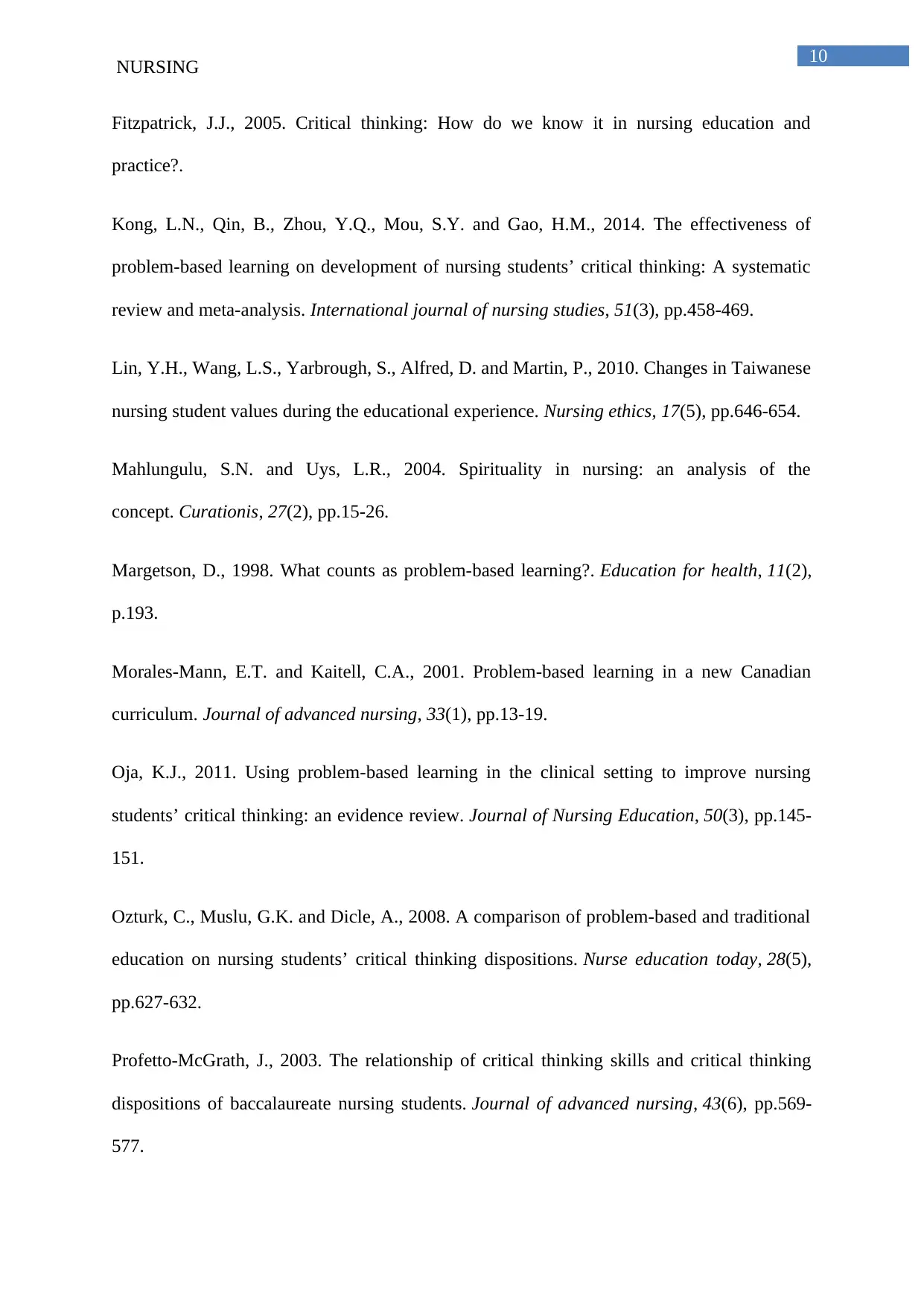
10
NURSING
Fitzpatrick, J.J., 2005. Critical thinking: How do we know it in nursing education and
practice?.
Kong, L.N., Qin, B., Zhou, Y.Q., Mou, S.Y. and Gao, H.M., 2014. The effectiveness of
problem-based learning on development of nursing students’ critical thinking: A systematic
review and meta-analysis. International journal of nursing studies, 51(3), pp.458-469.
Lin, Y.H., Wang, L.S., Yarbrough, S., Alfred, D. and Martin, P., 2010. Changes in Taiwanese
nursing student values during the educational experience. Nursing ethics, 17(5), pp.646-654.
Mahlungulu, S.N. and Uys, L.R., 2004. Spirituality in nursing: an analysis of the
concept. Curationis, 27(2), pp.15-26.
Margetson, D., 1998. What counts as problem-based learning?. Education for health, 11(2),
p.193.
Morales‐Mann, E.T. and Kaitell, C.A., 2001. Problem‐based learning in a new Canadian
curriculum. Journal of advanced nursing, 33(1), pp.13-19.
Oja, K.J., 2011. Using problem-based learning in the clinical setting to improve nursing
students’ critical thinking: an evidence review. Journal of Nursing Education, 50(3), pp.145-
151.
Ozturk, C., Muslu, G.K. and Dicle, A., 2008. A comparison of problem-based and traditional
education on nursing students’ critical thinking dispositions. Nurse education today, 28(5),
pp.627-632.
Profetto‐McGrath, J., 2003. The relationship of critical thinking skills and critical thinking
dispositions of baccalaureate nursing students. Journal of advanced nursing, 43(6), pp.569-
577.
NURSING
Fitzpatrick, J.J., 2005. Critical thinking: How do we know it in nursing education and
practice?.
Kong, L.N., Qin, B., Zhou, Y.Q., Mou, S.Y. and Gao, H.M., 2014. The effectiveness of
problem-based learning on development of nursing students’ critical thinking: A systematic
review and meta-analysis. International journal of nursing studies, 51(3), pp.458-469.
Lin, Y.H., Wang, L.S., Yarbrough, S., Alfred, D. and Martin, P., 2010. Changes in Taiwanese
nursing student values during the educational experience. Nursing ethics, 17(5), pp.646-654.
Mahlungulu, S.N. and Uys, L.R., 2004. Spirituality in nursing: an analysis of the
concept. Curationis, 27(2), pp.15-26.
Margetson, D., 1998. What counts as problem-based learning?. Education for health, 11(2),
p.193.
Morales‐Mann, E.T. and Kaitell, C.A., 2001. Problem‐based learning in a new Canadian
curriculum. Journal of advanced nursing, 33(1), pp.13-19.
Oja, K.J., 2011. Using problem-based learning in the clinical setting to improve nursing
students’ critical thinking: an evidence review. Journal of Nursing Education, 50(3), pp.145-
151.
Ozturk, C., Muslu, G.K. and Dicle, A., 2008. A comparison of problem-based and traditional
education on nursing students’ critical thinking dispositions. Nurse education today, 28(5),
pp.627-632.
Profetto‐McGrath, J., 2003. The relationship of critical thinking skills and critical thinking
dispositions of baccalaureate nursing students. Journal of advanced nursing, 43(6), pp.569-
577.
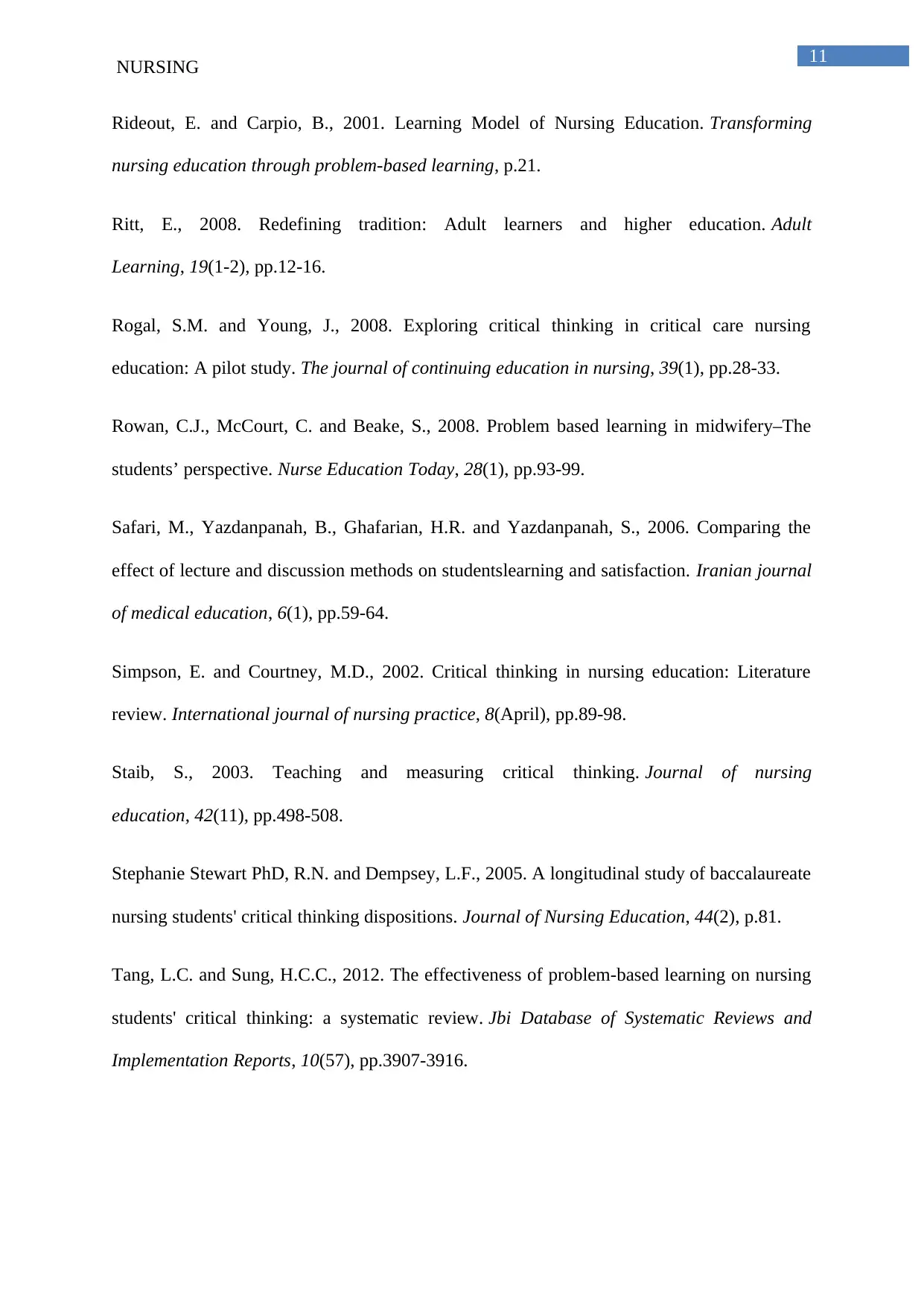
11
NURSING
Rideout, E. and Carpio, B., 2001. Learning Model of Nursing Education. Transforming
nursing education through problem-based learning, p.21.
Ritt, E., 2008. Redefining tradition: Adult learners and higher education. Adult
Learning, 19(1-2), pp.12-16.
Rogal, S.M. and Young, J., 2008. Exploring critical thinking in critical care nursing
education: A pilot study. The journal of continuing education in nursing, 39(1), pp.28-33.
Rowan, C.J., McCourt, C. and Beake, S., 2008. Problem based learning in midwifery–The
students’ perspective. Nurse Education Today, 28(1), pp.93-99.
Safari, M., Yazdanpanah, B., Ghafarian, H.R. and Yazdanpanah, S., 2006. Comparing the
effect of lecture and discussion methods on studentslearning and satisfaction. Iranian journal
of medical education, 6(1), pp.59-64.
Simpson, E. and Courtney, M.D., 2002. Critical thinking in nursing education: Literature
review. International journal of nursing practice, 8(April), pp.89-98.
Staib, S., 2003. Teaching and measuring critical thinking. Journal of nursing
education, 42(11), pp.498-508.
Stephanie Stewart PhD, R.N. and Dempsey, L.F., 2005. A longitudinal study of baccalaureate
nursing students' critical thinking dispositions. Journal of Nursing Education, 44(2), p.81.
Tang, L.C. and Sung, H.C.C., 2012. The effectiveness of problem-based learning on nursing
students' critical thinking: a systematic review. Jbi Database of Systematic Reviews and
Implementation Reports, 10(57), pp.3907-3916.
NURSING
Rideout, E. and Carpio, B., 2001. Learning Model of Nursing Education. Transforming
nursing education through problem-based learning, p.21.
Ritt, E., 2008. Redefining tradition: Adult learners and higher education. Adult
Learning, 19(1-2), pp.12-16.
Rogal, S.M. and Young, J., 2008. Exploring critical thinking in critical care nursing
education: A pilot study. The journal of continuing education in nursing, 39(1), pp.28-33.
Rowan, C.J., McCourt, C. and Beake, S., 2008. Problem based learning in midwifery–The
students’ perspective. Nurse Education Today, 28(1), pp.93-99.
Safari, M., Yazdanpanah, B., Ghafarian, H.R. and Yazdanpanah, S., 2006. Comparing the
effect of lecture and discussion methods on studentslearning and satisfaction. Iranian journal
of medical education, 6(1), pp.59-64.
Simpson, E. and Courtney, M.D., 2002. Critical thinking in nursing education: Literature
review. International journal of nursing practice, 8(April), pp.89-98.
Staib, S., 2003. Teaching and measuring critical thinking. Journal of nursing
education, 42(11), pp.498-508.
Stephanie Stewart PhD, R.N. and Dempsey, L.F., 2005. A longitudinal study of baccalaureate
nursing students' critical thinking dispositions. Journal of Nursing Education, 44(2), p.81.
Tang, L.C. and Sung, H.C.C., 2012. The effectiveness of problem-based learning on nursing
students' critical thinking: a systematic review. Jbi Database of Systematic Reviews and
Implementation Reports, 10(57), pp.3907-3916.
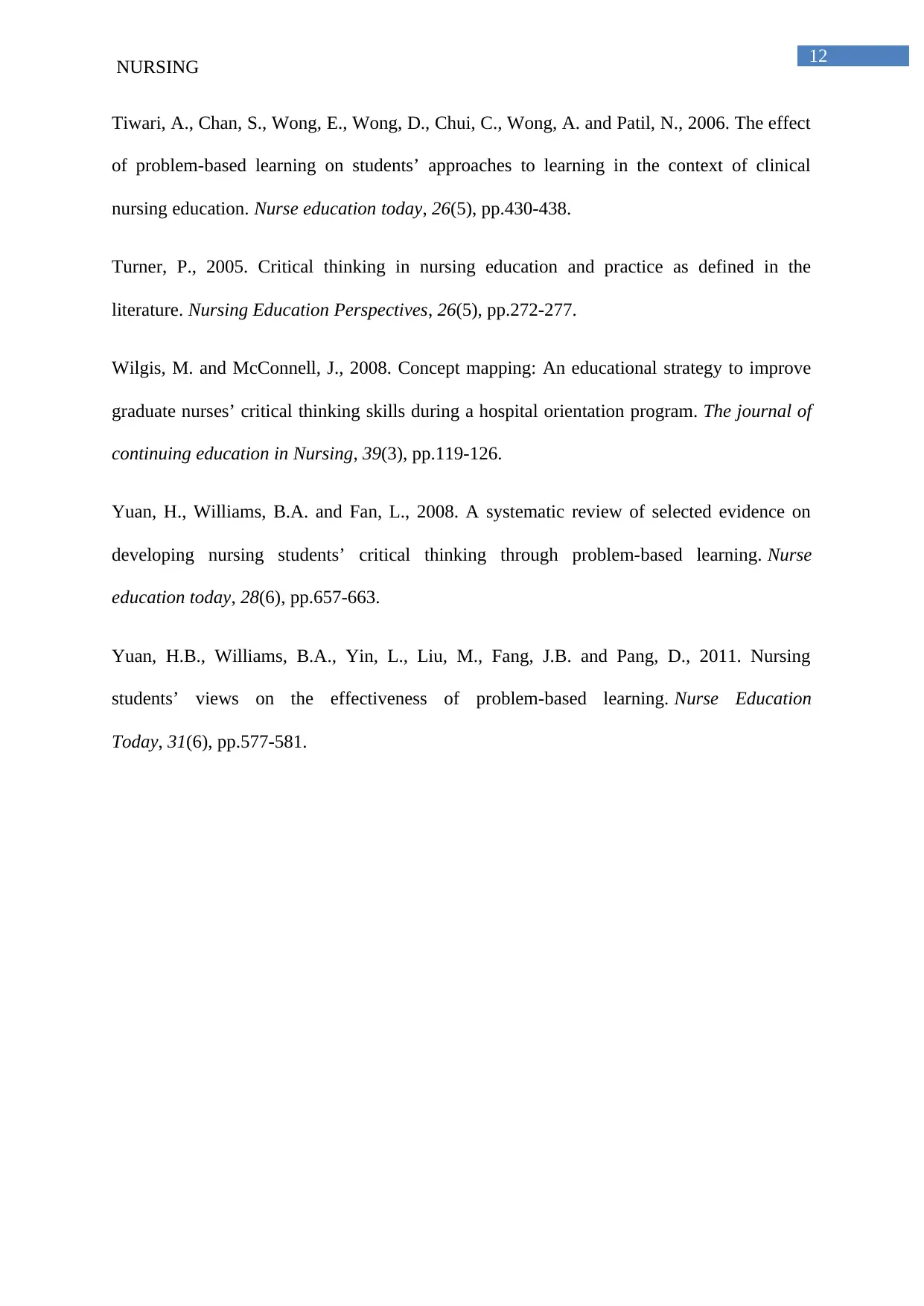
12
NURSING
Tiwari, A., Chan, S., Wong, E., Wong, D., Chui, C., Wong, A. and Patil, N., 2006. The effect
of problem-based learning on students’ approaches to learning in the context of clinical
nursing education. Nurse education today, 26(5), pp.430-438.
Turner, P., 2005. Critical thinking in nursing education and practice as defined in the
literature. Nursing Education Perspectives, 26(5), pp.272-277.
Wilgis, M. and McConnell, J., 2008. Concept mapping: An educational strategy to improve
graduate nurses’ critical thinking skills during a hospital orientation program. The journal of
continuing education in Nursing, 39(3), pp.119-126.
Yuan, H., Williams, B.A. and Fan, L., 2008. A systematic review of selected evidence on
developing nursing students’ critical thinking through problem-based learning. Nurse
education today, 28(6), pp.657-663.
Yuan, H.B., Williams, B.A., Yin, L., Liu, M., Fang, J.B. and Pang, D., 2011. Nursing
students’ views on the effectiveness of problem-based learning. Nurse Education
Today, 31(6), pp.577-581.
NURSING
Tiwari, A., Chan, S., Wong, E., Wong, D., Chui, C., Wong, A. and Patil, N., 2006. The effect
of problem-based learning on students’ approaches to learning in the context of clinical
nursing education. Nurse education today, 26(5), pp.430-438.
Turner, P., 2005. Critical thinking in nursing education and practice as defined in the
literature. Nursing Education Perspectives, 26(5), pp.272-277.
Wilgis, M. and McConnell, J., 2008. Concept mapping: An educational strategy to improve
graduate nurses’ critical thinking skills during a hospital orientation program. The journal of
continuing education in Nursing, 39(3), pp.119-126.
Yuan, H., Williams, B.A. and Fan, L., 2008. A systematic review of selected evidence on
developing nursing students’ critical thinking through problem-based learning. Nurse
education today, 28(6), pp.657-663.
Yuan, H.B., Williams, B.A., Yin, L., Liu, M., Fang, J.B. and Pang, D., 2011. Nursing
students’ views on the effectiveness of problem-based learning. Nurse Education
Today, 31(6), pp.577-581.
1 out of 13
Related Documents
Your All-in-One AI-Powered Toolkit for Academic Success.
+13062052269
info@desklib.com
Available 24*7 on WhatsApp / Email
![[object Object]](/_next/static/media/star-bottom.7253800d.svg)
Unlock your academic potential
© 2024 | Zucol Services PVT LTD | All rights reserved.





